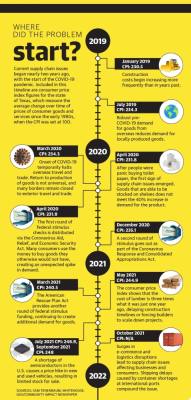Leander-based seafood business Savory Alaska is one example of how rising market costs have affected prices for consumers. Nathanael Ferguson, who owns the company with his wife, Sarah, said the seafood market, specifically shellfish prices, recently exploded.
Ferguson said crab has been difficult to get, and he chose to not buy spot prawns when the season opened in October because they would not be affordable for customers.
The business also stopped selling scallops because costs increased 71% in addition to a 38% increase in shipping costs. In November, Ferguson saw such a significant cost increase for his scallops order that he told the producer he needed to wait until prices moderate.
“I can’t pass that full cost increase onto my customers,” he said. “No one in their right mind would pay it.”
Fish like salmon, cod and halibut also increased but less dramatically, Ferguson said. One of Savory Alaska’s top products, halibut, saw prices increase about 19% from 2020 to 2021.
The Fergusons have chosen to split the cost increase difference with customers, and it is difficult to predict when the seafood industry will improve as fishermen do not know how much processors will pay for their products until just before each season.
“I want this to continue to be a product that our customers can afford,” Ferguson said. “In order to do that, I just have to eat a little bit of the price increase and hope that next year prices are more reasonable.”
What is happening
Supply chains refer to the trade of intermediate goods, “which is twice as large as the trade value of final goods,” according to the Texas comptroller’s office. In the summer, product and commodity shortages stemmed from the pandemic, which “only exposed and exacerbated existing vulnerabilities and risks to the supply chain network.”
Sam Tenenbaum, director of analytics and Central Texas economist for commercial real estate information company CoStar Group, said when pandemic restrictions were first put in place last year, both the demand for and the supply of most goods decreased dramatically.
However, as restrictions continue to lift and federal stimulus measures amplify demand for goods faster than expected, suppliers are having trouble keeping up, according to Tenenbaum.
“We all kind of expected the economy to weaken considerably [because of COVID-19 and] consumer spending to go down ... but that didn’t really happen,” Tenenbaum said. “A lot of the big factory operations can’t stop on a dime and then turn around and restart operations at full capacity in a few weeks. That’s not really how everything works.”
Tenenbaum said COVID-19 also changed the way consumers spend their money. Prior to the pandemic, services, not goods, accounted for the majority of consumer spending, but the pandemic changed that, he said.
“COVID[-19] sort of made those closer personal interactions that are much more service-oriented certainly more dangerous,” Tenenbaum said.
He said that shift led to consumers spending more on goods than services almost overnight—an increase in demand that helped contribute to inflation.
Scarce supplies
Smokey Mo’s BBQ, which is headquartered in Leander, has seen ongoing issues with finding paper goods for customers—including the restaurants’ increased number of to-go customers.
While the company has seen ebbs and flows of pork and beef availability, sourcing paper goods such as plastic bags and styrofoam cups has been an ongoing issue, said Chad Krause, the operations director for Smokey Mo’s BBQ, which has locations in the Austin, San Antonio and north Houston areas.
When available, there might be different sizes than wanted, such as 12-ounce cups when portions are only eight ounces. Restaurant managers have sourced products like styrofoam cups at wholesale stores like Sam’s Club when regular suppliers cannot send products to Smokey Mo’s.
The company has seen prices on these items increase up to 30%, Krause said.
“Instead of making adjustments and changing prices and marking up prices, we just took on that responsibility,” Krause said. “Hoping that it was short-term.”
The company rebranded earlier this year, and Krause said it has been impossible to find suppliers for new plastic bags or plastic “trophy cups.” He was told that their rebranded supplies might be ready in the second or third quarter of 2022.
“We might receive cups for a week, and then all of a sudden we are back to styrofoam cups,” Krause said. “It’s still very inconsistent.”
Krause also said Smokey Mo’s had periods where it bought brisket from three brands rather than their regular contracted supplier. There was also a period in August where a rib was substituted that cost double the price because it was the only option available.
Locally, Cedar Park Chamber of Commerce President Tony Moline said Cedar Park businesses have seen the gamut of issues from shipping issues with suppliers to delivery delays. These issues are coupled with staffing shortages and catalyzed with the February winter storm, which temporarily shut down some Texas manufacturing.
“I think people are really starting to see a lot of that come to fruition now that it’s shopping season,” Moline said. “People are starting to see things that are not in stock.”
Tenenbaum said he expects manufacturers to make a few changes in response to global supply chain issues so they are more prepared to deal with future disruptions.
The most notable change Tenenbaum predicts is the reduction of overseas manufacturing in favor of local manufacturing to reduce reliance on the global supply chain.
“Now that we sort of understand the struggles of a global supply chain, I think what we’ll see is onshoring or nearshoring, where we either bring the manufacturing process back to the United States or we keep more inventory of that item,” Tenenbaum said.
Shipping dilemmas
Papa Noel Christmas Trees saw “an anomaly” in the 2020 tree-buying season, which led to the company’s first-ever sellouts, said Beau Coan, the company’s operations manager. The trends from 2020 made the 2021 season difficult to plan, so Papa Noel opened its seven Central Texas tree locations on Nov. 17—the company’s earliest opening date ever—and shipped its tree stock earlier than typical.
“People want their tree way earlier than ever before,” he said. “They’re looking to get the best looking tree they can, and they know those go the quickest.”
Coan said inventory shortages were not a major issue for Papa Noel since the company supplies a majority of its trees. Between 7,000-8,000 trees come from their North Carolina farm, and about 4,000 trees come from the Pacific Northwest.
But the company experienced challenges in receiving their West Coast trees as the trucking industry saw driver shortages and increasing fuel costs, Coan said. U.S. Bureau and Labor Statistics data shows as of October, roughly 9,000 trucking industry jobs remained unfilled from pre-pandemic levels nationwide.
Coan estimated a 10-15% increase in shipping costs, which varies by the week and where trees are coming from. Trees are cheaper to ship from the east coast than the west coast, Coan said.
“It’s one of those things as a seasonal business that we just have to stomach and deal with,” Coan said. “We have to get trees down here regardless, so we kind of got to play the game.”
Tree buyers are seeing small increases in the cost of their tree this year, but the increased shipping costs ultimately are passed onto the customer to keep the business alive, Coan said. The company chose to not increase prices in 2020 due to the pandemic as the company is sensitive to increasing prices despite shipping costs rising every year.
“This year we just have to play the game in order for us to stay afloat,” Coan said. “We have to increase it a little bit to cover our costs. But we’re trying to be gentle on that.”
Similarly, furniture shoppers may see increased costs in addition to months-long wait times on some furniture deliveries. Adam Block, owner of Austin’s Furniture Outlet in Cedar Park, said the Bell Boulevard furniture shop saw peak demand in May 2020 in the early pandemic months as people spent more time at home. Today, demand has returned close to pre-pandemic levels, though the store still sees high demand as a result of area growth.
Block said furniture wait times depend on the location of the manufacturer. Furniture from Mexico might have a two-to-three-week delivery schedule while furniture made in Asia might not be ready until March 2022. Wait times also depend on the furniture type and what is already in stock, Block said.
Customers could pay up to 30% more for sofas, bedroom sets and other furniture, Block said.
“It really depends on what you were to pick out,” Block said. “Some stuff is severely impacted, but some stuff is doing OK.”
Carson Ganong contributed to this report.






